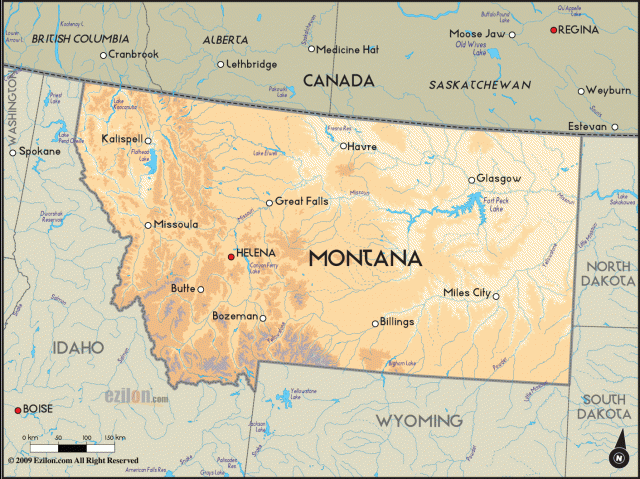The State of Montana
AT A GLANCE
Name: Montana comes from the Spanish word montana, which means “mountainous.”
Nicknames: Treasure State, Big Sky Country
Capital: Helena
Size: 147,046 sq. mi. (380,849 sq km)
Population: 1,032,949 (2015 est)
Statehood: Montana became the 41st state on November 8, 1889.
Electoral votes: 3 (2016)
U.S. representatives: 1 (until 2016)
State tree: ponderosa pine
State flower: bitterroot
State fish: Western meadowlark
Highest point: Granite Peak, 12,799 ft. (3,901 m)

THE PLACE
Montana is the fourth-largest state in the Unites States. It was one of the last states to be settled, and even today it retains a rugged and wild frontier character.
Montana is somewhat isolated by the Rocky Mountains, which cover the western two-fifths of the state. The mountains are steep and densely forested, and many are snow-covered throughout the year. This area also has many crystal-blue lakes, such as Flathead Lake, which covers 189 square miles (490 sq km) in northwestern Montana. Valuable deposits of minerals including copper, gold, lead, platinum, silver, and zinc exist in the western mountain region.
Eastern Montana is part of the Great Plains region, which stretches from Canada in the north all the way to Mexico in the south. This area has rolling hills, broad plains, fertile soil, and wide river valleys. A few small mountain ranges, such as the Bears Paw, Big Snowy, and Judith, cover parts of this area. The climate in the eastern plains of Montana is different from the cool, snowy climate of the west.
Temperatures in the eastern prairie can be extreme—bitterly cold in the winter and hot in the summer.
Facts and Firsts
- There are more deer, elk, and antelope in Montana than people. The average square mile of land contains 1.4 elk, 1.4 pronghorn antelope, and 3.3 deer.
- Forty-six of Montana's 56 counties are considered “frontier” and contain six or fewer people per square mile.
- Montana has more species of mammals than any other state.
- Montana has the largest grizzly bear population of the contiguous 48 states.
- Yellowstone National Park, located in Montana and Wyoming, is the oldest national park in the world.
- More people visit Glacier National Park than any other spot in Montana.
- In 1888, Helena was home to more millionaires than anyplace else in the world.
THE PAST
Once the home of many different Native American tribes, Montana was not settled by whites until the 1860s. During the early 1800s, French trappers explored the area, and in 1803 the United States bought the land from France as part of the Louisiana Purchase.
The cattle industry came to Montana's eastern plains in the 1850s, and railroads were quickly completed to ease cattle transport. Montana did not receive much attention, though, until 1862, when gold was discovered there and settlers rushed west to try to strike it rich. As Montana became more settled, the area's Native Americans fought to keep their lands.
In 1876, Sioux and Cheyenne wiped out a U.S. Army regiment led by General George Armstrong Custer in the Battle of the Little Bighorn. By the 1880s, however, most Native Americans had been forced out, and mining began in earnest. Montana's population grew rapidly as miners came from all over the United States to take advantage of the gold, silver, and copper resources of the region. In 1889, Montana was admitted to the Union.
Lumber and mining were keystones of Montana's industry until the Great Depression of the 1930s, when demand for goods dropped. World War II brought prosperity to Montana as the state provided food and metals for the war effort. Energy production took off after oil fields were discovered along the Montana–North Dakota border in the early 1950s. Tourism also grew and became an important source of revenue.
During the 1980s, economic problems slowed Montana's industrial growth, while technological advances in farming and mining cost many Montana residents their jobs.
THE PRESENT
Montana remains one of the least populated and least developed states. Montana has retained its traditional industries—coal and petroleum mining continue to support the state's economy.
Lumbering also remains a major industry, and today Montana processes much of its wood into products such as plywood, pencils, telephone poles, and prefabricated houses.
In the eastern plains, crop and livestock farming are important revenue-producing activities for residents. Approximately 22,000 farms raise beef and dairy cattle; grow wheat, barley, and hay; and produce sugar beets. Food-processing industries prepare much of this food for world consumption. Montana encourages these industries and many others, including tourism.
Born in Montana
- Dorothy Baker, author
- Gary Cooper, actor
- Chet Huntley, television newscaster
- Myrna Loy, actress
- Jeannette Rankin, first woman elected to Congress
- Martha Raye, actress